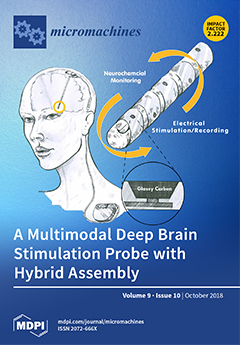A wide range of localization techniques has been proposed recently that leverage smartphone sensors. Context awareness serves as the backbone of these localization techniques, which helps them to shift the localization technologies to improve efficiency and energy utilization. Indoor-outdoor (IO) context sensing plays
[...] Read more.
A wide range of localization techniques has been proposed recently that leverage smartphone sensors. Context awareness serves as the backbone of these localization techniques, which helps them to shift the localization technologies to improve efficiency and energy utilization. Indoor-outdoor (IO) context sensing plays a vital role for such systems, which serve both indoor and outdoor localization. IO systems work with collaborative technologies including the Global Positioning System (GPS), cellular tower signals, Wi-Fi, Bluetooth and a variety of smartphone sensors. GPS- and Wi-Fi-based systems are power hungry, and their accuracy is severed by limiting factors like multipath, shadowing, etc. On the other hand, various built-in smartphone sensors can be deployed for environmental sensing. Although these sensors can play a crucial role, yet they are very less studied. This research aims at investigating the use of ambient magnetic field data alone from a smartphone for IO detection. The research first investigates the feasibility of utilizing magnetic field data alone for IO detection and then extracts different features suitable for IO detection to be used in machine learning-based classifiers to discriminate between indoor and outdoor environments. The experiments are performed at three different places including a subway station, a shopping mall and Yeungnam University (YU), Korea. The training data are collected from one spot of the campus, and testing is performed with data from various locations of the above-mentioned places. The experiment involves Samsung Galaxy S8, LG G6 and Samsung Galaxy Round smartphones. The results show that the magnetic data from smartphone magnetic sensor embody enough information and can discriminate the indoor environment from the outdoor environment. Naive Bayes (NB) outperforms with a classification accuracy of 83.26%, as against Support vector machines (SVM), random induction (RI), gradient boosting machines (GBM), random forest (RF), k-nearest neighbor (kNN) and decision trees (DT), whose accuracies are 67.21%, 73.38%, 73.40%, 78.59%, 69.53% and 68.60%, respectively. kNN, SVM and DT do not perform well when noisy data are used for classification. Additionally, other dynamic scenarios affect the attitude of magnetic data and degrade the performance of SVM, RI and GBM. NB and RF prove to be more noise tolerant and environment adaptable and perform very well in dynamic scenarios. Keeping in view the performance of these classifiers, an ensemble-based stacking scheme is presented, which utilizes DT and RI as the base learners and naive Bayes as the ensemble classifier. This approach is able to achieve an accuracy of 85.30% using the magnetic data of the smartphone magnetic sensor. Moreover, with an increase in training data, the accuracy of the stacking scheme can be elevated by 0.83%. The performance of the proposed approach is compared with GPS-, Wi-Fi- and light sensor-based IO detection.
Full article






